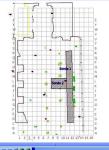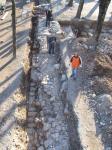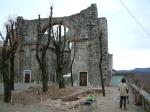Summary (English)
In December 2005 we conducted rescue archaeological excavation at the site of Crekvina – collapsed church of Ascension of Virgin Mary in Kastav. We found remains of stone walls bound by mortar and distinguished two construction phases. The remains visible today are related to the Jesuit construction works mentioned in the permit of the Bishop of Pula from 1769 and in which the bishop allowed the removal of the old, collapsed church and the construction of a new one. Older architectural remains can be related with the structure that had probably collapsed during the earthquakes that were shaking the region of Rijeka between 1750 and 1754 and which was mentioned in documents for the first time in 1634.
Most pottery fragments belong to the modern age and a smaller part belongs to the Prehistory and the Antiquity. The finds can be related to the prehistoric hillfort settlement which was probably situated at the top of the hill and with Castellum or Castra, the settlement from that period was mentioned in the written sources from the Late Antiquity.
The town of Kastav is located in the immediate hinterland of Rijeka, 4 km in the northwest direction. It is located on a strategically important, rocky elevation from which there is a view of all the Kvarner islands, Učka and the eastern Istrian coast, the karst hinterland and the entire Primorje from Rijeka to Vinodol. The geographical position, which dominates the Kvarner Bay, influenced its origin and development in the past. Since the 19th century, on almost all archaeological maps, Kastav has been recorded as a prehistoric site, i.e. a settlement and necropolis from the Early Iron Age. Prehistoric finds were found in several places around the town itself, as well as inside its walls. The most representative find from the Late Bronze Age – beginning of the Early Iron Age is a sword with a cup-shaped hilt, which, based on the analysis of the fittings, is associated with Balkan workshops (Goran Skelac 2006, Hrvatski arheološki godišnjak 2/2005, 262-264).
- Goran Skelac
Director
- Goran Skelac
Team
- Helena Nodilo
Research Body
- Geoarheo d.o.o.
Funding Body
- Grad Kastav






![Download [PDF]](/excavation/skins/fasti/images/results/download_sml.png)


